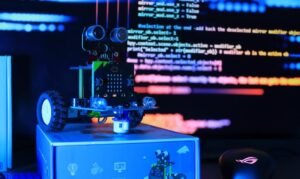Applications Definition
Applications, also known as apps, are software programs designed to perform specific tasks or functions on electronic devices such as computers, smartphones, and tablets. They are created to enhance user experience and provide solutions to various needs and interests. With a wide range of applications available across different platforms, understanding their definition and purpose can help users make informed choices and maximize their device’s potential.
Key Takeaways
- Applications, or apps, are software programs designed for specific tasks on electronic devices.
- They enhance user experience and provide solutions to various needs and interests.
- Applications can be downloaded from platforms like app stores and marketplaces.
- They offer a diverse range of functionalities, from productivity tools to entertainment and social media platforms.
Applications can be broadly classified into two categories: native apps and web apps. Native apps are specifically developed for a particular device or operating system, such as iOS or Android. They are installed directly on the device and can access the device’s features and functionality. For example, a native weather application can access the device’s GPS to provide location-based forecasts. On the other hand, web apps are accessed through web browsers and run on web servers. They function independently of the operating system and are not installed on the device. Instead, users access them through a URL or bookmark, making them accessible across different platforms.
Types of Applications
Applications serve various purposes and cater to different user needs. They can be classified into several categories:
- Productivity Apps: These applications help users manage tasks, organize schedules, and enhance work efficiency. Examples include project management tools, note-taking apps, and calendar applications.
- Entertainment Apps: Entertainment apps provide users with access to games, music streaming services, video platforms, and social media applications. They offer a wide range of content to keep users entertained and connected.
- Utility Apps: These applications provide specific functions that simplify tasks or enhance device capabilities. Examples include barcode scanners, language translators, and flashlight apps.
Applications can also be classified based on the platform they are developed for. This includes:
Platform-based Classification
| Platform | Description |
|---|---|
| iOS | Applications developed specifically for Apple’s iOS operating system, used in devices like iPhones and iPads. |
| Android | Applications developed for the Android operating system, used by a wide range of devices from various manufacturers. |
| Windows | Applications developed for the Windows operating system, compatible with computers and mobile devices running Windows. |
Regardless of the type or platform, applications have become an integral part of our daily lives, offering convenience, entertainment, and functionality at our fingertips. With the continuously evolving app market, users have an ever-expanding range of options to choose from.
Benefits of Using Applications
Using applications offers numerous benefits to users:
- Increased productivity and efficiency in daily tasks.
- Access to personalized and relevant content.
- Enhanced communication and connectivity with others.
- Improved organization and time management.
From simple utility apps to complex games and social media platforms, applications have transformed the way we interact with technology. As the demand for apps continues to grow, developers are constantly innovating and creating new applications to meet user needs and stay ahead of the competition.
Conclusion
Applications, or apps, have become an essential part of our digital lives, serving diverse purposes from productivity to entertainment. Understanding the definition and types of applications can help users make informed decisions about which ones to use on their electronic devices. Whether it’s improving productivity, staying connected, or simply having fun, there is an application out there to enhance every aspect of our daily lives.

Common Misconceptions
Misconception 1: Applications are the same as software programs
One common misconception is that applications and software programs are the same thing. While they are related, there are some distinctions.
- Applications refer to specific software tools designed to perform certain tasks or functions.
- Software programs, on the other hand, can encompass a wider range of applications and can refer to the overall collection of software installed on a computer.
- Applications are usually designed to be user-friendly and provide a more targeted functionality, while software programs can include system software and utilities.
Misconception 2: Web applications and mobile applications are the same
Another misconception is that web applications and mobile applications are the same. While they can have similarities, they are different in several ways.
- Web applications are accessed through web browsers and require an internet connection, while mobile applications are downloaded and installed on mobile devices.
- Web applications are built using web technologies such as HTML, CSS, and JavaScript, while mobile applications are usually developed using platform-specific languages like Java or Swift.
- Web applications can be accessed across multiple devices with internet access, while mobile applications are specific to the operating system of the mobile device.
Misconception 3: All applications are free
A common misconception is that all applications are free to use and download. However, this is not the case.
- While there are many free applications available, there are also paid applications that offer additional features or premium content.
- Some applications follow a freemium model, where the basic functionalities are free but extra features require a payment.
- Paid applications often provide better support, regular updates, and enhanced security measures compared to their free counterparts.
Misconception 4: Applications are always safe and secure
Many people assume that applications are always safe and secure to use. However, this is a misconception that can lead to potential risks.
- Some applications may contain vulnerabilities or have weak security measures, making them susceptible to hacking or data breaches.
- Downloading applications from unofficial sources or not verifying the authenticity of the application can lead to malware infections or compromised devices.
- It is crucial to research and only download applications from trusted sources, ensure they are regularly updated, and review the permissions they require.
Misconception 5: Applications are only for tech-savvy individuals
Another misconception is that applications are only meant for tech-savvy individuals and require advanced technical skills to use.
- While some applications may have complex features that require technical knowledge, many applications are designed with user-friendly interfaces and are suitable for individuals of all skill levels.
- The user experience of applications has improved over time, with intuitive designs and helpful tutorials that make them accessible to a wide range of users.
- Application developers often prioritize usability and strive to make their applications easy to navigate and understand.

Applications of Artificial Intelligence
Artificial Intelligence (AI) is rapidly transforming various industries and sectors, revolutionizing the way we live and work. From healthcare to finance, AI is revolutionizing decision-making processes and enabling more efficient and accurate outcomes. This article explores the diverse and fascinating applications of AI in different areas of our lives.
AI in Healthcare:
AI is making significant advancements in the healthcare industry, enhancing diagnosis, treatment, and overall patient care. This table showcases some of the key AI applications in healthcare.
| Application | Benefits |
|---|---|
| AI-assisted Diagnostics | Improved accuracy and efficiency in disease diagnosis |
| Robotic Surgery | Precision and control in surgical procedures |
| Personalized Medicine | Customized treatments for patients based on genetic data |
| Drug Discovery | Accelerated identification of potential new drugs |
| Virtual Nursing Assistants | 24/7 patient monitoring and support |
AI in Finance:
Artificial Intelligence is reshaping the financial sector, offering improved risk management, fraud detection, and personalized customer experiences. This table highlights some fascinating AI applications in finance.
| Application | Benefits |
|---|---|
| Algorithmic Trading | Increased speed and accuracy in executing trades |
| Chatbots for Customer Service | Enhanced customer support and reduced response times |
| Fraud Detection | Improved detection of fraudulent transactions |
| Risk Assessment | Enhanced evaluation of creditworthiness and loan approvals |
| Financial Planning | Personalized investment advice and portfolio management |
AI in Transportation:
Transportation and logistics are being revolutionized by AI technologies, enabling more efficient and sustainable systems. This table presents some exciting AI applications impacting transportation.
| Application | Benefits |
|---|---|
| Autonomous Vehicles | Improved road safety and reduced traffic congestion |
| Route Optimization | Efficient path planning for deliveries and transportation |
| Traffic Management | Real-time monitoring and intelligent traffic control |
| Safety Inspections | Automated inspections of infrastructure and vehicles |
| Demand Prediction | Optimized resource allocation and capacity planning |
AI in Education:
AI is shaping the future of education by personalizing learning experiences and providing intelligent tutoring systems. This table showcases AI applications that are transforming education.
| Application | Benefits |
|---|---|
| Virtual Classrooms | Remote learning opportunities and global connectivity |
| Adaptive Learning Platforms | Customized learning pathways for individual students |
| Intelligent Grading | Automated assessment and feedback for assignments |
| Smart Content Creation | AI-generated educational content and simulations |
| Student Support Systems | Early identification of struggling students and personalized interventions |
Conclusion:
The applications of Artificial Intelligence are vast and diverse, impacting various industries and sectors. From healthcareand finance to transportation and education, AI is revolutionizing the way we live and work. With the potential to improve accuracy, efficiency, and personalization, AI is set to play a significant role in shaping our future.
Frequently Asked Questions
What is the definition of applications?
Applications, also known as apps, are software programs designed to perform specific tasks and functions on electronic devices such as computers, smartphones, and tablets. These programs are created to enhance productivity, entertainment, communication, or offer various utilities to users.
How do applications work?
Applications work by utilizing the resources of electronic devices to execute their programmed instructions. They interact with the operating system and hardware components to perform tasks ranging from simple calculations to complex data processing. Applications can access necessary data, use system APIs, and provide a graphical user interface (GUI) for user interaction.
What are the different types of applications?
There are various types of applications available, including:
- Web Applications: Software accessed through web browsers.
- Mobile Applications: Designed for smartphones and tablets.
- Desktop Applications: Installed on personal computers or laptops.
- Enterprise Applications: Used by organizations for business purposes.
- Utility Applications: Programs offering specific functionalities (e.g., calculators, file managers).
How are applications developed?
Applications are typically developed using programming languages such as Java, JavaScript, C++, Python, or Swift, depending on the platform and requirements. Developers write code, test it, and compile it into executable applications. Integrated Development Environments (IDEs) like Visual Studio and Xcode provide tools to simplify the development process.
Can applications run on multiple operating systems?
Yes, some applications are designed to be compatible with multiple operating systems. Cross-platform applications are developed using frameworks like React Native, Xamarin, or PhoneGap, which allow simultaneous deployment on different platforms such as iOS, Android, and Windows.
Where can I find applications to download and install?
Applications can be downloaded and installed from various sources, including:
- Official App Stores: Platform-specific app marketplaces like Apple App Store or Google Play Store.
- Third-Party Websites: Online platforms offering applications for download.
- Developer Websites: Developers’ websites or software repositories.
Are applications secure to use?
While most applications strive to provide a secure environment, not all apps are entirely secure. It is essential to download applications from trusted sources to minimize the risk of malware or unauthorized access to personal information. Reading user reviews and checking permissions can also help assess an app’s security.
Can applications be updated?
Yes, applications can be updated to fix bugs, introduce new features, improve performance, or address security vulnerabilities. Updates are usually provided by developers or distributed through designated app stores. Enabling automatic updates ensures that installed applications remain up to date.
What should I do if an application is not functioning correctly?
If an application is not functioning correctly, try the following troubleshooting steps:
- Close and reopen the application.
- Restart the device.
- Ensure the application is up to date.
- Clear the application cache or data.
- Uninstall and reinstall the application.
- Contact the application’s developer for support.
Can applications be uninstalled?
Yes, applications can be uninstalled from devices. The process for uninstalling applications varies depending on the operating system. Generally, users can uninstall applications through system settings or by long-pressing the app icon and selecting the appropriate uninstall option.





